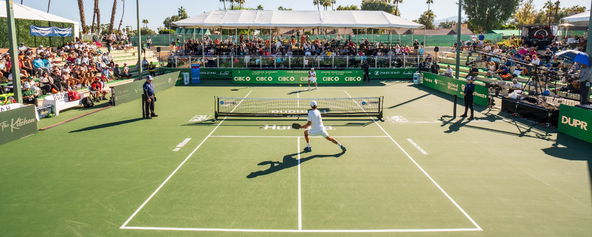
Stacking in pickleball: What it is, how it works, when to use it
If you’ve ever watched high-level pickleball, you’ve probably heard the announcers mention the term “stacking.”
But what exactly does that mean, and should you be doing it?
Let’s break it down.
What is stacking?
Stacking is a doubles strategy used to position teammates on the same side of the court to gain a strategic advantage. It’s especially helpful when:
- One player is left-handed and the other is right-handed.
- One player is more skilled, agile, or aggressive.
- You want to keep a specific player in the middle for better forehand control.
By stacking, you maintain ideal positioning throughout the game, even after serving or receiving.
ADVERTISEMENT
How do you stack?
Before you start, decide who should be on which side of the court:
Left-side player
Usually the stronger or more dominant player (especially if they’re right-handed).
Right-side player
Often less aggressive or a support-style player (e.g., focused on setup shots).
When serving
- Start in standard serving formation with the right-side player serving first.
- After scoring a point, the left-side player stays on the left, and the server (right-side player) slides into position on the right after serving.
- As long as the correct server is in place, players can stand wherever they want on the court.
When receiving
Odd score
Right-side player must return serve from the left. After the return, they slide back to the right.
Even score
Right-side player returns from the right, and no switching is needed.
Stacking may confuse your opponents, especially at recreational levels, but that’s their problem. Just make sure the correct player serves or receives.
Why use stacking?
Stacking can create huge advantages:
- Maximize your strengths: Keep your best player in the middle.
- Forehand control: Especially helpful with a lefty-righty combo.
- Better angles: Opens up attacking opportunities.
- Tactical flexibility: Force your opponents to adjust to your game.
Disadvantages of stacking
While effective, stacking isn’t for everyone. Here are some potential downsides:
- Communication issues: Miscommunication about positioning or shot responsibility can cause errors.
- Loss of flexibility: Players may get stuck on a side they’re less comfortable with.
- Predictability: Higher-level opponents may pick up on your tendencies quickly.
- Footwork challenges: Switching sides after serve or return must be seamless to avoid penalties or poor court coverage.
- Imbalance: If one player is much weaker, stacking might expose them more.
Final thoughts
Stacking is a powerful strategy, but only if you and your partner are on the same page. Talk it through, know your roles, and decide if stacking plays to your strengths.
Used correctly, stacking can hide weaknesses, maximize your team's strengths, and give you the upper hand—no matter who’s across the net.
Related articles

Could DUPR really lead to a divorce?
According to a Reddit user, the pickleball rating ended his marriage.
17 days ago
-Victoria Radnothy

Five game-changing tips to elevate your pickleball skills
Learn from one of the best coaching minds in the business, John Cincola.
21 days ago
-Victoria Radnothy
.jpg?width=592&height=237&optimizer=image)
Post-Pickleball Cooldown Routines: Science Proven Methods
23 days ago
-Guest Author

Mastering Our Support Tools
23 days ago
-Tyrece Warner





